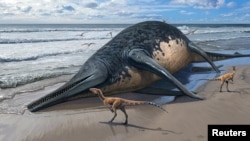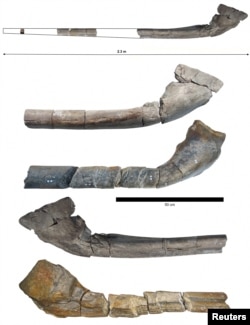An ancient fossil found by a girl and her father on a beach in England belongs to a creature that might have been among the largest animals ever on Earth.
Researchers said in a recent study that the fossilized bone, called a surangular, was from a reptile called an ichthyosaur that lived in the sea. Based on its size, compared to the same bone in closely related ichthyosaurs, the researchers estimated that the creature was between 22 and 26 meters long. They named it Ichthyotitan severnensis.
That would make it possibly the largest known marine reptile. Its size would be close to the largest whales alive today. The blue whale, considered the largest animal ever to have lived, can reach about 30 meters in length.
Marine reptiles lived in the world's oceans at the same time that dinosaurs lived on the land. Ichthyosaurs disappeared 90 million years ago. They came in several sizes. The creatures ate fish and other sea animals.
Ichthyotitan, however, is known only from two jawbones. The jaw forms the lower part of the mouth.
Ruby Reynolds and her father Justin Reynolds found one of the bones in 2020 at Blue Anchor in Somerset. The other bone is from a different Ichthyotitan individual found in 2016, along the Somerset coast at Lilstock.
Dean Lomax was the lead writer of the study published recently in PLOS ONE. Lomax said, "It is quite remarkable to think that gigantic, blue whale-sized ichthyosaurs were swimming in the oceans around the time that dinosaurs were walking on land in what is now the UK (Britain) during the Triassic Period.”
The Triassic Period describes a time over 200 million years ago.
Ruby Reynolds was 11 at the time she and her father discovered the fossil surangular bone on the beach. Ruby continued to search the area and found a second piece - much larger than the first - partly buried in the ground. They then contacted Lomax, an ichthyosaur expert, and more parts of the bone were unearthed.
Ruby’s part in the discovery has led to comparisons with Mary Anning. Anning was a 19th century British fossil hunter who, among other things, discovered ichthyosaur fossils when she was 12.
"I think Mary Anning was an incredible paleontologist, and it's amazing to be compared to her," Ruby said.
Justin Reynolds added, "It has been an amazing...and fun experience to work with these experts, and we are proud to be part of the team and co-authors of a scientific paper which names a new species and genus.”
Fossil collector Paul de la Salle found the 2016 remains now identified as Ichthyotitan.
The big marine reptile was a member of a family of giant ichthyosaurs called Shastasauridae. These creatures lived 13 million years later than other ichthyosaurs. They survived until a world-wide event caused many kinds of animals to disappear about 201 million years ago at the end of the Triassic Period.
No other fossils from Ichthyotitan have been discovered. But the researchers have been able to guess at its appearance based on other members of its family, including Shonisaurus from British Columbia, Canada.
Study co-writer Jimmy Waldron used the term humbled – meaning to be made to feel less important or proud – to describe the discoveries.
Waldron said, "Discoveries like this create incredible moments where we become humbled at our size and place in the world.”
I’m John Russell.
Will Dunham reported on this story for Reuters. John Russell adapted it for VOA Learning English.
________________________________________
Words in This Story
fossil – n. the fossilized remains of a plant or animal that lived in the distant past
marine -- -adj. of or relating to the sea or the plants and animals that live in the sea
remarkable – adj. unusual or surprising; impressive
gigantic – adj. very large
paleontologist – n. the science that deals with the fossils of animals and plants that lived very long ago
species – n. a group of animals or plants that are similar and can produce young animals or plants
genus – n. a group of related animals or plants that includes several or many different species











Forum